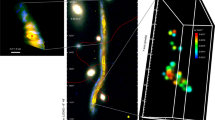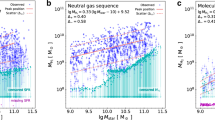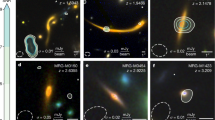Abstract
The gas accretion and star formation histories of galaxies like the Milky Way remain an outstanding problem in astrophysics1,2. Observations show that 8 billion years ago, the progenitors to Milky Way-mass galaxies were forming stars 30 times faster than today and were predicted to be rich in molecular gas3, in contrast to the low present-day gas fractions (<10%)4–6. Here we show the detection of molecular gas from the CO (J = 3–2) emission (rest-frame 345.8 GHz) in galaxies at redshifts z = 1.2–1.3, selected to have the stellar mass and star formation rate of the progenitors of today’s Milky Way-mass galaxies. The CO emission reveals large molecular gas masses, comparable to or exceeding the galaxy stellar masses, and implying that most of the baryons are in cold gas, not stars. The total luminosities of the galaxies from star formation and CO luminosities yield long gas consumption timescales. Compared to local spiral galaxies, the star formation efficiency, estimated from the ratio of total infrared luminosity (LIR) to CO emission, has remained nearly constant since redshift z = 1.2, despite the order of magnitude decrease in gas fraction, consistent with the results for other galaxies at this epoch7–10. Therefore, the physical processes that determine the rate at which gas cools to form stars in distant galaxies appear to be similar to that in local galaxies.
This is a preview of subscription content, access via your institution
Access options
Subscribe to this journal
Receive 12 digital issues and online access to articles
$119.00 per year
only $9.92 per issue
Buy this article
- Purchase on Springer Link
- Instant access to full article PDF
Prices may be subject to local taxes which are calculated during checkout



Similar content being viewed by others
References
Guedes, J., Callegari, S., Madau, P. & Mayer, L. Forming realistic late-type spirals in a ΛCDM universe: the Eris simulation. Astrophys. J. 742, 76 (2011).
Martig, M., Bournaud, F., Croton, D. J., Dekel, A. & Teyssier, R. A diversity of progenitors and histories for isolated spiral galaxies. Astrophys. J. 756, 26 (2012).
Papovich, C. et al. ZFOURGE/CANDELS: on the evolution of M* galaxy progenitors from z =3 to 0.5. Astrophys. J. 803, 26 (2015).
Sage, L. J. Molecular gas in nearby galaxies. I: CO observations of a distance-limited sample. Astron. Astrophys. 272, 123–136 (1993).
Leroy, A. K. et al. Heracles: The HERA CO line extragalactic survey. Astron. J. 137, 4670–4696 (2009).
Saintonge, A. et al. COLD GASS, an IRAM legacy survey of molecular gas in massive galaxies. I: relations between H2, H i, stellar content and structural properties. Mon. Not. R. Astron. Soc. 415, 32–60 (2011).
Daddi, E. et al. Very high gas fractions and extended gas reservoirs in z = 1.5 disk galaxies. Astrophys. J. 713, 686–707 (2010).
Magdis, G. E. et al. The molecular gas content of z = 3 Lyman break galaxies: evidence of a non-evolving gas fraction in main-sequence galaxies at z > 2. Astrophys. J. 758, L9 (2012).
Magnelli, B. et al. Dust temperature and CO–H2 conversion factor variations in the SFR-M plane. Astron. Astrophys. 548, A22 (2012).
Tacconi, L. J. et al. Phibss: molecular gas content and scaling relations in z∼1-3 massive, main-sequence star-forming galaxies. Astrophys. J. 768, 74 (2013).
Snaith, O. N. et al. The dominant epoch of star formation in the Milky Way formed the thick disk. Astrophys. J. 781, L31 (2014).
Bernard, E. J. et al. The spatially-resolved star formation history of the M31 outer disc. Mon. Not. R. Astron. Soc. 453, L113–L117 (2015).
Licquia, T. C. & Newman, J. A. Improved estimates of the Milky Way’s stellar mass and star formation rate from hierarchical Bayesian meta-analysis. Astrophys. J. 806, 96 (2015).
De Lucia, G. et al. Elemental abundances in Milky Way-like galaxies from a hierarchical galaxy formation model. Mon. Not. R. Astron. Soc. 445, 970–987 (2014).
Dekel, A. et al. Cold streams in early massive hot haloes as the main mode of galaxy formation. Nature 457, 451–454 (2009).
Genzel, R. et al. The rapid formation of a large rotating disk galaxy three billion years after the Big Bang. Nature 442, 786–789 (2006).
Tacconi, L. J. et al. High molecular gas fractions in normal massive star-forming galaxies in the young Universe. Nature 463, 781–784 (2010).
Genzel, R. et al. Combined CO and dust scaling relations of depletion time and molecular gas fractions with cosmic time, specific star-formation rate, and stellar mass. Astrophys. J. 800, 20 (2015).
Wisnioski, E. et al. The KMOS3D survey: design, first results, and the evolution of galaxy kinematics from 0.7 <= z <= 2.7. Astrophys. J. 799, 209 (2015).
Ceverino, D., Dekel, A. & Bournaud, F. High-redshift clumpy discs and bulges in cosmological simulations. Mon. Not. R. Astron. Soc. 404, 2151–2169 (2010).
Genel, S., Dekel, A. & Cacciato, M. On the effect of cosmological inflow on turbulence and instability in galactic discs. Mon. Not. R. Astron. Soc. 425, 788–800 (2012).
Gabor, J. M. & Bournaud, F. Delayed star formation in high-redshift stream-fed galaxies. Mon. Not. R. Astron. Soc. 437, L56–L60 (2014).
Agertz, O. & Kravtsov, A. V. On the interplay between star formation and feedback in galaxy formation simulations. Astrophys. J. 804, 18 (2015).
Straatman, C. M. S. et al. The FourStar Galaxy Evolution Survey (ZFOURGE): ultraviolet to far-infrared catalogs, medium–bandwidth photometric redshifts with improved accuracy, stellar masses, and confirmation of quiescent galaxies to z∼3.5. Astrophys. J. 830, 51 (2016).
Daddi, E. et al. CO excitation of normal star-forming galaxies out to z = 1.5 as regulated by the properties of their interstellar medium. Astron. Astrophys. 577, A46 (2015).
Bolatto, A. D. et al. High-resolution imaging of PHIBSS z ∼ 2 main-sequence galaxies in CO J = 1–0. Astrophys. J. 809, 175 (2015).
Aravena, M. et al. CO(1–0) line imaging of massive star-forming disc galaxies at z=1.5–2.2. Mon. Not. R. Astron. Soc. 442, 558–564 (2014).
Casey, C. M., Narayanan, D. & Cooray, A. Dusty star-forming galaxies at high redshift. Phys. Rep. 541, 45–161 (2014).
Carilli, C. L. & Walter, F. Cool gas in high-redshift galaxies. Annu. Rev. Astron. Astrophys. 51, 105–161 (2013).
Scoville, N. et al. ISM masses and the star formation law at z=1 to 6: ALMA observations of dust continuum in 145 galaxies in the COSMOS survey field. Astrophys. J. 820, 83 (2016).
Persson, S. E. et al. FourStar: the near-infrared imager for the 6.5 μm Baade telescope at Las Campanas Observatory. Publ. Astron. Soc. Pacif. 125, 654–682 (2013).
Grogin, N. A. et al. CANDELS: the Cosmic Assembly Near-infrared Deep Extragalactic Legacy Survey. Astrophys. J. Suppl. Ser. 197, 35 (2011).
Koekemoer, A. M. et al. CANDELS: the Cosmic Assembly Near-infrared Deep Extragalactic Legacy Survey — the Hubble Space Telescope observations, imaging data products, and mosaics. Astrophys. J. Suppl. Ser. 197, 36 (2011).
Tomczak, A. R. et al. Galaxy stellar mass functions from ZFOURGE/CANDELS: an excess of low-mass galaxies since z = 2 and the rapid buildup of quiescent galaxies. Astrophys. J. 783, 85 (2014).
Mutch, S. J., Croton, D. J. & Poole, G. B. The mid-life crisis of the Milky Way and M31. Astrophys. J. 736, 84 (2011).
Moster, B. P., Naab, T. & White, S. D. M. Galactic star formation and accretion histories from matching galaxies to dark matter haloes. Mon. Not. R. Astron. Soc. 428, 3121–3138 (2013).
van Dokkum, P. G. et al. The assembly of Milky-Way-like galaxies since z∼2.5. Astrophys. J. 771, L35 (2013).
Wellons, S. & Torrey, P. An improved probabilistic approach for linking progenitor and descendant galaxy populations using comoving number density. Preprint at https://arxiv.org/abs/1606.07815 (2016).
Vanzella, E. et al. The Great Observatories Origins Deep Survey. VLT/FORS2 spectroscopy in the GOODS-South field: part III. Astron. Astrophys. 478, 83–92 (2008).
Kriek, M. et al. An ultra-deep near-infrared spectrum of a compact quiescent galaxy at z = 2.2. Astrophys. J. 700, 221–231 (2009).
Tomczak, A. R. et al. The SFR-M* relation and empirical star-formation histories from ZFOURGE* at 0.5 < z < 4. Astrophys. J. 817, 118 (2016).
Elbaz, D. et al. GOODS-Herschel: an infrared main sequence for star-forming galaxies. Astron. Astrophys. 533, A119 (2011).
Magnelli, B. et al. Evolution of the dusty infrared luminosity function from z = 0 to z = 2.3 using observations from Spitzer. Astron. Astrophys. 528, A35 (2011).
Magnelli, B. et al. The deepest Herschel-PACS far-infrared survey: number counts and infrared luminosity functions from combined PEP/GOODS-H observations. Astron. Astrophys. 553, A132 (2013).
Berta, S. et al. PEP Full Public Data Release (DR1): PACS Data (Max Planck Institute, 2013); http://irsa.ipac.caltech.edu/data/Herschel/PEP/docs/readme%5FPEP%5Fglobal.pdf
Lutz, D. et al. PACS Evolutionary Probe (PEP) — a Herschel key program. Astron. Astrophys. 532, A90 (2011).
Rieke, G. H. et al. Determining star formation rates for infrared galaxies. Astrophys. J. 692, 556–573 (2009).
Chary, R. & Elbaz, D. Interpreting the cosmic infrared background: constraints on the evolution of the dust-enshrouded star formation rate. Astrophys. J. 556, 562–581 (2001).
Dale, D. A. et al. Infrared spectral energy distributions of nearby galaxies. Astrophys. J. 633, 857–870 (2005).
Howell, J. H. et al. The Great Observatories All-sky LIRG Survey: comparison of ultraviolet and far-infrared properties. Astrophys. J. 715, 572–588 (2010).
McMullin, J. P., Waters, B., Schiebel, D., Young, W. & Golap, K. CASA architecture and applications. In Astronomical Data Analysis Software and Systems XVI (eds Shaw, R. A., Hill, F. & Bell, D. J ) 127 (Astronomical Society of the Pacific Conference Series, 2007).
Daddi, E. et al. Different star formation laws for disks versus starbursts at low and high redshifts. Astrophys. J. 714, L118–L122 (2010).
Bolatto, A. D., Wolfire, M. & Leroy, A. K. The CO-to-H 2 conversion factor. Annu. Rev. Astron. Astrophys. 51, 207–268 (2013).
Feldmann, R., Gnedin, N. Y. & Kravtsov, A. V. The X-factor in galaxies. I: dependence on environment and scale. Astrophys. J. 747, 124 (2012).
Narayanan, D., Krumholz, M. R., Ostriker, E. C. & Hernquist, L. A general model for the CO–H 2 conversion factor in galaxies with applications to the star formation law. Mon. Not. R. Astron. Soc. 421, 3127–3146 (2012).
Genzel, R. et al. The metallicity dependence of the CO−H 2 conversion factor in z > 1 star-forming galaxies. Astrophys. J. 746, 69 (2012).
Pérez-Montero, E. et al. Physical properties of galaxies and their evolution in the VIMOS VLT Deep Survey. II. Extending the mass–metallicity relation to the range z ∼ 0.89–1.24. Astron. Astrophys. 495, 73–81 (2009).
Zahid, H. J., Kewley, L. J. & Bresolin, F. The mass–metallicity and luminosity–metallicity relations from DEEP2 at z ∼ 0.8. Astrophys. J. 730, 137 (2011).
Stott, J. P. et al. A fundamental metallicity relation for galaxies at z = 0.84–1.47 from HiZELS. Mon. Not. R. Astron. Soc. 436, 1130–1141 (2013).
Chabrier, G. Galactic stellar and substellar initial mass function. Publ. Astron. Soc. Pacif. 115, 763–795 (2003).
Planck Collaboration, Planck 2015 results. XIII: Cosmological parameters. Astrophys. Astron. 594, A13 (2016).
Riess, A. G. et al. A 24% determination of the local value of the Hubble constant. Astrophys. J. 826, 56 (2016).
Gao, Y. & Solomon, P. M. The star formation rate and dense molecular gas in galaxies. Astrophys. J. 606, 271–290 (2004).
Combes, F. et al. Galaxy evolution and star formation efficiency at 0.2 < z < 0.6. Astron. Astrophys. 528, A124 (2011).
Combes, F. et al. Gas fraction and star formation efficiency at z < 1.0. Astron. Astrophys. 550, A41 (2013).
Acknowledgements
The authors thank their colleagues on the CANDELS and ZFOURGE surveys for providing high quality data. The authors also thank the ALMA staff for facilitating the observations and aiding in the calibration and reduction process. The authors acknowledge generous support from the Mitchell Institute for Fundamental Physics and Astronomy at Texas A&M University. This paper makes use of the following ALMA data: ADS/JAO.ALMA#2011.0.01234.S. ALMA is a partnership of the European Southern Observatory (representing its member states), the National Science Foundation (USA) and the National Institutes of Natural Sciences (Japan), together with the National Research Council (Canada), the National Science Council and the Academia Sinica Institute of Astronomy and Astrophysics (Taiwan) and the Korea Astronomy and Space Science Institute (Republic of Korea), in cooperation with the Republic of Chile. The Joint ALMA Observatory is operated by the European Southern Observatory, Associated Universities, Inc./National Radio Astronomy Observatory and the National Astronomical Observatory of Japan. The National Radio Astronomy Observatory is a facility of the National Science Foundation operated under cooperative agreement by Associated Universities, Inc.
Author information
Authors and Affiliations
Contributions
C.P. led the ALMA observing programme, handled the data reduction and led the writing of the manuscript. I.L., K.G., R.Q., L.S., C.S. and K.-V.T. contributed extensively to the ZFOURGE data set, used in much of the analysis. S.L.F., D.F. and R.C.L. contributed to the design of the ALMA observing programme and assisted in the reduction and interpretation of the ALMA data. G.B. and K.G. assisted in the interpretation of the ALMA data. M.D. and H.I. carried out the data analysis of the Spitzer and Herschel imaging. All coauthors contributed to the writing of the manuscript and to the ALMA observing programme.
Corresponding author
Ethics declarations
Competing interests
The authors declare no competing financial interests.
Supplementary information
Supplementary Information
Supplementary Tables 1-2, Supplementary Figures 1–4 (PDF 322 kb)
Rights and permissions
About this article
Cite this article
Papovich, C., Labbé, I., Glazebrook, K. et al. Large molecular gas reservoirs in ancestors of Milky Way-mass galaxies nine billion years ago. Nat Astron 1, 0003 (2017). https://doi.org/10.1038/s41550-016-0003
Received:
Accepted:
Published:
DOI: https://doi.org/10.1038/s41550-016-0003



